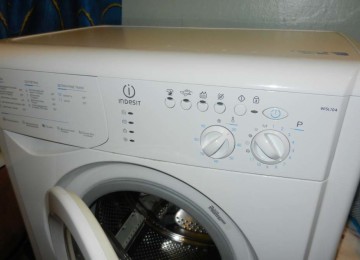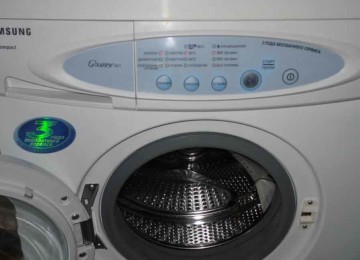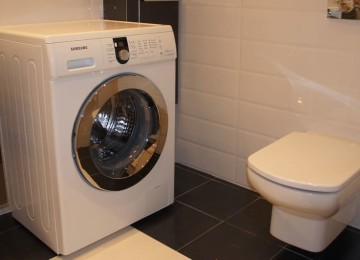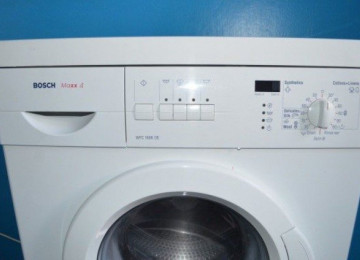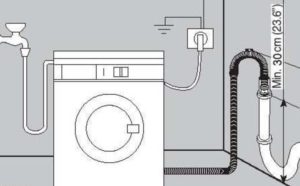 Correct installation of household appliances ensures good operation without malfunctions. The siphon effect in a washing machine is the random draining of liquid into the sewer or its return from the drainage system to the tank. Devices installed on the upper floors of multi-apartment buildings suffer more often from this defect.
Correct installation of household appliances ensures good operation without malfunctions. The siphon effect in a washing machine is the random draining of liquid into the sewer or its return from the drainage system to the tank. Devices installed on the upper floors of multi-apartment buildings suffer more often from this defect.
Methods for connecting to the sewer system
Water drainage is organized in the following ways:
- The drain hose is attached to the edge of the plumbing fixture.
- Connects to the siphon under the washbasin.
- Screwed to the pipe under the bathtub.
In the first case, a permanent connection is not made, but during washing the possibility of using a bathtub, washbasin or toilet is limited.
Connection to siphon under the sink is the most popular method. The drain is mounted permanently, without restricting access to plumbing. A siphon with an outlet for an additional pipe is installed for connection. The hose is connected to the drain channel under the bathtub if the equipment is located correctly. The height of the connection point is taken into account for the normal operation of the check valve of the washing machine.
As an example of communicating vessels, consider the tank in a washing machine and the pipe connected to the drain. The knee at the bend divides it into 2 parts.If the long half of the tube is connected to the sewer, then the column of liquid in it will be greater than in the short part during drainage. The pressure in the communicating vessels is different, so the liquid from the container will drain until its amount is equal to the rupture point.
When self-draining occurs
Even experienced craftsmen make mistakes during installation; they do not level the level correctly, resulting in self-draining of unused clean water. The machine is emptied and the liquid is drained into the sewer. The installation instructions for any device indicate that the outlet of the drain hole into the sewer is located at a height of 50 to 100 cm from the floor level.
The height of 50-60 cm exceeds the maximum permissible level in the drum. Self-draining occurs when the hose is installed lower, so the washing water is immediately removed into the sewer.
Bending the hose above the water level in the machine allows you to carry out a wash cycle and work out part of the program. Once the bleed pump is activated, water will move through the hose and a siphon effect will result.
Purpose of the check valve

The device provides protection against the siphon effect in the washing machine and inhibits the return of waste water to the drum. After draining, the waste liquid goes back into the machine if the device is installed incorrectly. The flap valve does not obstruct the outlet and does a good job of preventing water from entering the tank.
Types of valves
Classification:
- Solid;
- Segmented;
- Mortise;
- Wall-mounted;
- Non-return valve installed in the siphon under the sink.
All devices are designed to protect against the siphon effect in the washing machine and prevent contamination of the tank. Segmented anti-siphons are used when working with dirty tap water. They are easier to disassemble and clean from debris.
A mortise check valve is inserted into the drain running through the sewer. First, the drain is equipped with an insert, then the product is inserted into it.
Siphon devices are placed under the sink and are suitable for any type of plumbing.
A check valve against the siphon effect in a new washing machine is installed in the following situations:
- The machine is connected directly to the drain when the connection cannot be raised. A check valve is installed when the pipe is low.
- A standard hose configuration is connected to the washbasin drain without a check valve, since the siphon effect does not occur in such systems.
The valve protecting the drain of the washing machine can be installed independently if necessary.
Principle of operation
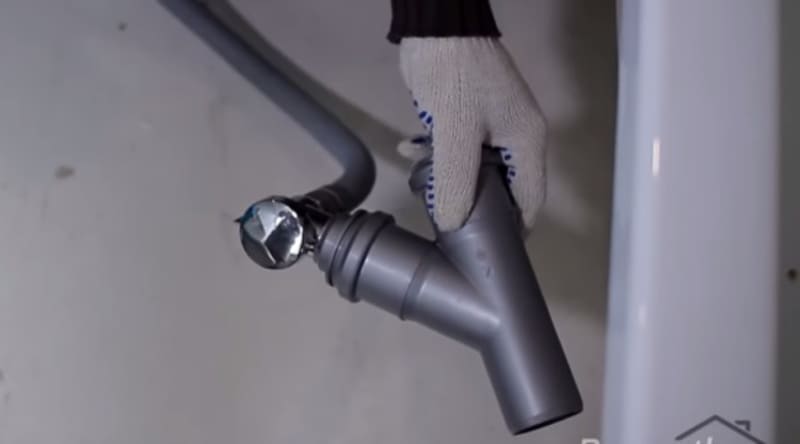
The siphon effect stops after installing the check valve. The device is often mounted in a walled-up pipe; the junction of the products is covered with special reflectors. Tap water enters the washing machine through the inlet valve, the return valve is responsible for the correct drainage of waste after the washing program is stopped and prevents the return of dirt.
The operating mode of the washing machine is sometimes disrupted after proper installation, an unpleasant odor appears or the wash takes too long. The siphon effect is the root of these problems and occurs when the diameter of the sewer pipe is larger than the hoses that come with the equipment.
The difference affects the appearance of discharged pressure, a slight difference affects the outflow of waste water. Modern technology takes away the missing liquid from the water supply, so the washing time increases and the quality of laundry cleaning decreases. This is the siphon effect, which a check valve helps prevent.
Connection Tips
When choosing an installation method You need to make sure that the hose does not fall into the water. Specialists know what to do in such a situation. The serviceability of the sewer system is checked before installation, the pipes are cleaned, and fast and free outflow is organized.
The tube pulsates during operation of the machine, so it is necessary to secure it firmly to prevent leaks. When the pump is turned on abruptly, a jerk occurs, which can cause the connection to break.






